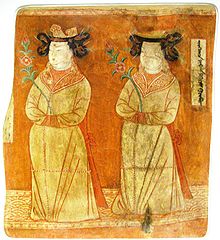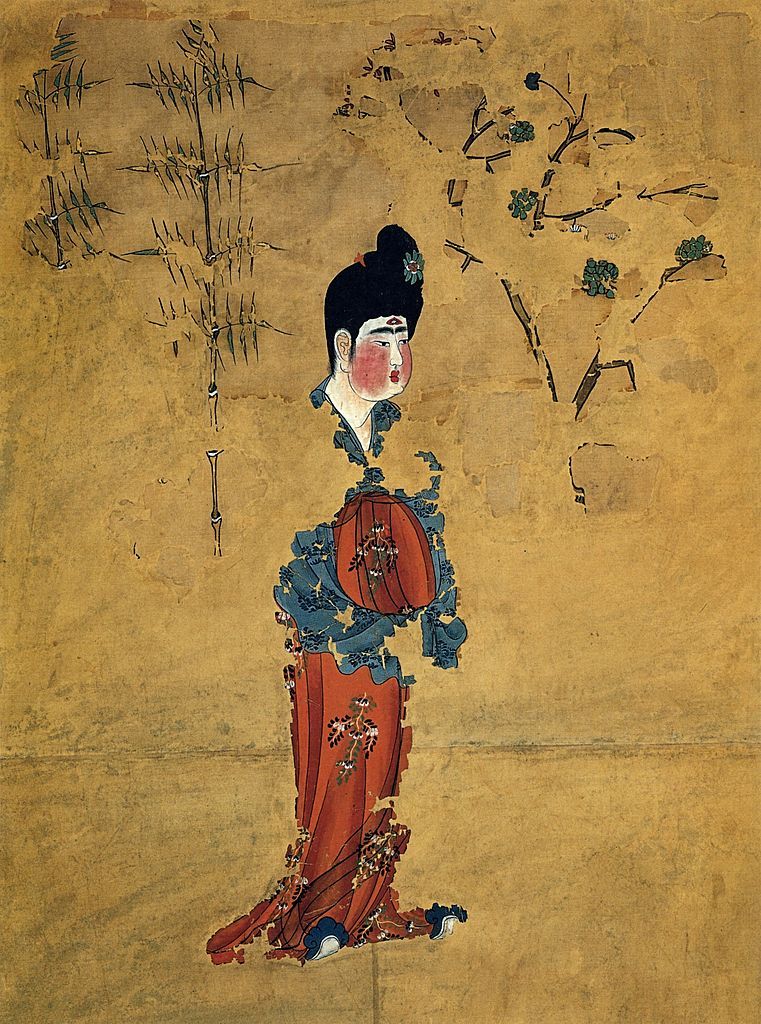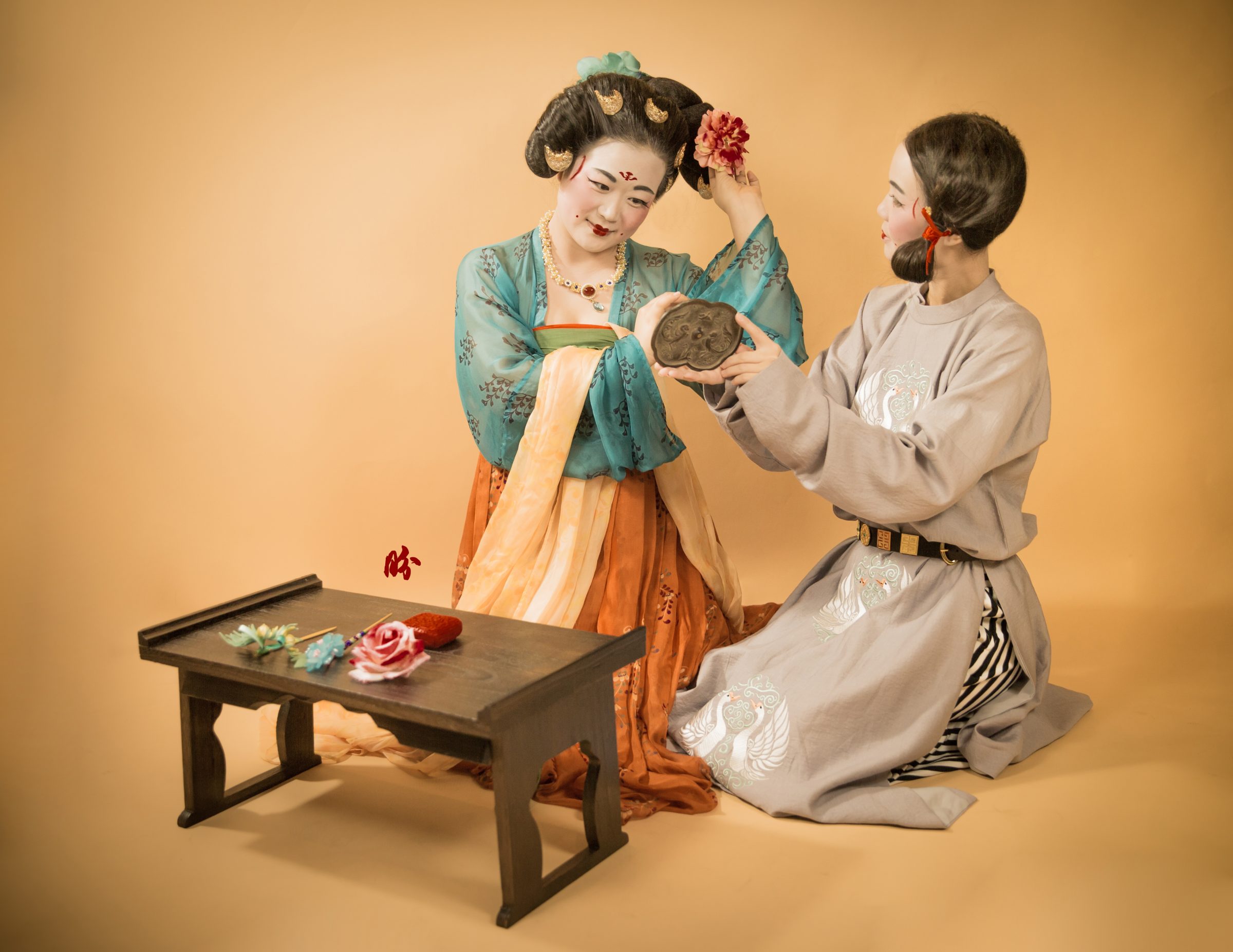Your cart is currently empty!
High & Mid Tang–Cross-dressing & Plus-size beauties

Whenever one speaks of the Tang dynasty (618-907 AD) beauties, it’s always the archetypical image of Yang Gui Fei/Yang Yu Huan, who was a beloved concubine of an emperor (Emperor Xuanzong, 685-762 AD) during High/Mid Tang period, and known for being a plus-size beauty.
However, I feel the need to reiterate and clarify that plus-size =/= unhealthily obese. Now bear in mind that from Early Tang dynasty, the Chinese had already abandoned the pursuit of being fragile and thin and opted for a more sporty, well-built body shape. It is my own personal opinion that this is in part due to their natural built being bigger frame than the traditional Han Chinese (since they have central Asian/Turkic blood), so their traditional definition of beauty naturally extended into their mixed heritage with the Han Chinese.
Suzanne E. Cahill, in her essay “Our Women are Acting like Foreigners’ Wives!” Western Influences on Tang Dynasty Women’s Fashion also theorised that such a pursuit for plus-size beauty in the 8th and 9th century by Chinese women could likely be due to influence from the West, or Central Asia (i.e. Uyghur), citing the painting below as an example:

Just like how the Westerners were interest in Asia and looked to the exotic East for sources of inspiration in their artwork in the last century or so, during Tang dynasty, the West was China’s greatest muse. With increased exposure to the Western culture through trade via the silk road, coupled with the rulers’ personal ancestry and connections with the West, it was no wonder that the nomadic tribes had a strong influence in the Chinese fashion of that time.
Not very familiar with history of Queen regents in Europe/Central Asia, so did a quick wiki check and seems like Queen regents like Parsbit (Khazar–Turkic people–730s CE), Olga of Kiev (East slavic tribe–about 9th century) etc. were possibly those referred to by Suzanne. It definitely seems like there was this almost-universal rise in female rulers across Europe and Asia around 7-9th century. Examples are Wu Ze Tian (first and only female emperor in Chinese history, during Tang dynasty), many Japanese empresses who ruled Japan throughout this period, and even in Korea!
If you have enough time and curiosity, do check out this wiki list and the links to read up more about each individual: https://en.wikipedia.org/wiki/List_of_queens_regnant
FASCINATING!
So besides a shift towards the pursuit for a fuller body, as a result of foreign influences, women also had extremely diverse and unconventional make-ups. Throughout Chinese history, Han women always adored thin and long eyebrows. Perhaps it’s due to the nature of the traditional Han Chinese features having thin almond shape eyes, or that preference for slim and slender body in all other periods (except Tang, Tang is so exceptional), so such eyebrows suited the Chinese features and gave women that extra elegance and gentleness. However, with a fuller body, a more westernised look, and a larger, rounder face, it is thus fashionable to use strong and larger patches of colours on their faces. Rouge took up most part of the face, and eyebrows were drawn rather thickly, with large prints/shapes pasted on foreheads. The kind of difference is somewhat similar to how the Japanese women today would have really natural make-up to accentuate their gentle femininity whereas Europeans/Americans would have really bold and strong make-up to express their individuality and identity.
There was even a painting of an eyeliner that’s drawn almost like the Egyptians, where the eyeliner was extended to the hairline!

By the way, this dress is one of my favourite! It’s made of full silk which is really light and soft, and it is made in the semblance of an actual painting from the era:

And there’s also this famous hairstyle called the 坠马髻 which literally meant the ‘fallen-off-the-horse’ hairstyle. It looked like you’ve done too much horse riding and your hair had come somewhat undone:

The trend of painting two red scar-like/wound-like marks were particularly popular during Tang dynasty, and were to be found on many artefacts from that era. This scar-like mark first emerged during the Northern and Southern dynasties, when a palace maiden doted on by an emperor injured herself, leaving scars on the side of her face but the emperor continued adoring her. This served as an endorsement for the trend of beauty in the imperfection. This trend ended shortly after the Tang dynasty, as the general spirit and pursuits changed as well. It’s not unlike the irrational obsession with foot-binding during Song–Qing dynasty, which also stemmed from a practice/pursuit by emperor’s concubines in the imperial court.
Generally, women are a lot bolder with make-up. I’ll do another entry at a later period to talk about the kind of cool make-up styles they did which might be beyond your wildest imagination!
Anyway, back to the topic on female empowerment. Women during Tang dynasty also wore men’s round-neck robes liberally. You’d have thought that it’s something that’s only common in modern society, where there’s greater acceptance of gender equality and fluidity. But people from Tang dynasty, which existed more than a thousand years ago, have already been doing that. Initially it was amongst women of higher status, such as Princess Tai Ping (beloved daughter of Empress Wu Ze Tian), but later on many of the servant girls started wearing them as well, paired with a very fashionable stripe pants! It’s mainly out of convenience that servant girls wore them, cos they’re really good for moving about and doing chores.

Before I end this, thought it’s interesting to just note that while it was common for Tang dynasty elites and servants to cross-dress, it was not the only attempt in history of Chinese. In fact, it was also said that the Cheongsam or qipao was also developed from the long Manchurian male robe. Educated women at the turn of the 20th century sought to have a male dress in their pursuit for gender equality. Although similar styles were worn by Manchurian women during Qing dynasty, they were a lot more elaborate and their sleeves got bigger and looser towards the end of the Qing dynasty, so the ones that were adopted by Han Chinese women after the establishment of the Republic were closer to the male Manchurian robe instead (perhaps, thus the name Cheongsam 长衫). So it’s always interesting to see how overtime there’s this rise in feminism/female power, it is reflected in their dresses.
That’s all from me–sorry for the long post!
2 responses to “High & Mid Tang–Cross-dressing & Plus-size beauties”

That’s really fascinating! And I think some elements that had been utilized in ancient Chinese fashion has made a comeback, without us even noticing. Like those striped pants, the long jackets and the ‘palazzo pants’ of the Song dynasty. They wouldn’t seem out of place in today’s world!

Yes exactly! Fashion is always cyclical! And tend to be driven by the elite class typically.

Leave a Reply